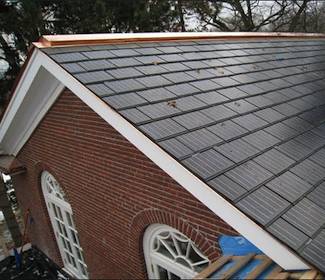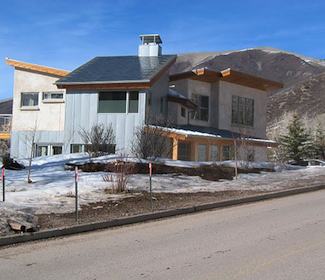Photovoltaic Shingles

Photovoltaic Shingles - Atlantis Energy Systems Sunslates
Powering your home with the energy of the sun is the dream of many green home owners. Unfortunately, there have historically been some obstacles to residential solar power, including high up-front costs, complicated installation, and the appearance of large solar panels on a homes roof or in a yard.
Stealthy Solar: Photovoltaic Shingles
Continuing advancements in solar design and improvements in efficiency are changing all of that. For those homeowners looking for solar power without the look of large solar panels (or who live in areas where they're frowned upon), a newer option is photovoltaic, or solar, shingles.
You can think of a photovoltaic shingle as a shingle on steroids. Designed to look like a traditional asphalt shingle, they will protect your roof and are as durable and flexible as regular shingles. They're light and easy to install. They're all of this, plus they provide clean, emission-free electricity from the sun to the home.
A Brief (Very Brief) History of Photovoltaic Shingles
Photovoltaic shingles have only been around since 2005.What Do Photovoltaic Shingles Look Like?
Photovoltaic shingles are similar in size and shape to asphalt shingles.They are dark in color, and are installed flat against the roof, which can be aesthetically pleasing to some who wish to avoid the look of large solar panels on the roof.
Types of Photovoltaic Shingles

Photovoltaic Shingles - Atlantis Energy Systems Sunslates
There are two types of photovoltaic shingles. The original photovoltaic shingles were made from silicon, the material most commonly used in solar panels. Silicon shingles remain the most efficient form of photovoltaic shingle.
A new thin-film shingle developed by Dow uses CIGS (copper indium gallium diselenide, quite a mouthful!) laminated in a thin film over the shingle material. This new design is flexible and lightweight, but is currently less efficient than silicon shingle technology.
It is, however, less expensive to manufacture and install. Dow estimates an installation time of 10 hours for an average-sized roof, half the time of older silicon shingle designs.
Photovoltaic Shingles: How Much Power?
When it comes to solar power, it's all about efficiencies. Photovoltaic shingles are no exception. Today's solar shingles will produce between 13 and 63 watts of power in full sunlight, depending on the brand and type of shingle. For an example of how many shingles would be needed, using shingles with a 13 watt output, 77 tiles would be needed to cover 100 square feet of roof, producing a kilowatt of energy.

Photovoltaic Shingles - Atlantis Energy Systems Sunslates
Photovoltaic Shingles: Durability Factors
Photovoltaic shingles are designed to protect your roof as well as a traditional asphalt shingle, shielding it from rain, wind, snow and hail. Traditional solar panels are built to last literally for decades, but since photovoltaic shingles are still such a new technology, there is not much real-world information on their long-term durability.
Photovoltaic Shingles vs. Traditional Solar Panels: Considerations
Photovoltaic shingles are rapidly catching on as a popular residential solar power option due to their appearance and ease of installation. However, they may not be a good choice for every rooftop. Here are some things to consider if you're thinking about solar shingles:
- The roof needs to have a proper angle and orientation to receive adequate sunlight. The proper angle depends on where your home is located, and the optimum angle will change during different times of the year.
- The roofing substrate of your roof needs to be able to handle high temperatures since the dark solar shingles will absorb a lot of heat from the sun. The substrate should also have proper air circulation to reduce heat buildup in the space below.
- Being such a new technology, relatively few installers are using photovoltaic shingles. As they become more and more prevalent in the marketplace, this should become less and less the case.
Let's take a look at how traditional solar panels compare:
- Solar panels can be angled to catch the maximum amount of sunshine even if the roof is at an inadequate slope or is not facing the proper direction.
- Solar panels can be installed on poles on the home's property rather than the roof. This has a benefit of making them easier to adjust for the sun's changing angle at different times of the year, and also makes them easier to clean and maintain.
- Solar panels can be moved or relocated from the roof if necessary without damaging or replacing the roof. If you move, so can the solar panels.
- Solar panels have decades of research and development behind them. They are currently more efficient than solar shingles, so not as much roof space is needed to create a similar amount of electricity.
- Traditional solar panel technology is currently less expensive than solar shingles, but this is slowly changing. Shingles are installed much quicker than panels, so cost comparisons should be closely examined to determine which technology works best with your budget.
Solar Power: What To Do With It
Whether you install photovoltaic shingles or traditional photovoltaic panels, you will need to decide how to store the energy they collect. The easiest and cheapest way to install solar power is to use it as a supplement to the electric grid. Your home uses solar power during the day, then traditional electricity during the times when the sun's not around. This can dramatically reduce your home's use of polluting, non-renewable energy sources. Battery backup systems that store energy to use during off-peak hours are much more complex and expensive, and have turnaround payoffs of decades. These systems are available, however, for those looking to go completely off the grid without concern for up-front costs.
comments powered by Disqus

























































































































































































